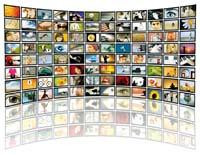Science and technology in television news

During the second half of 2009 we investigated the chains of ETB1, ETB2, TVE1 and La2 in the twelve randomly chosen days (nine working days and three weekend days), all of them informative evening. It has occurred that there are no reports or that they are restricted. In this issue I will present some of the extremes of our matrix of analysis, namely discourse. Nor will I pay attention to the comparisons between television channels.
Unimportant
A total of 69 news stories on science and technology have been detected in 64 working days and 5 weekends; 16 news from ETB1 and 23 news from ETB2, all of them weekly. In TVE1 there have been 18 news, 13 working days and 5 weekends, and finally 12 La2 news has been issued.
Of the 69 news, 3 (4%) have been presented in the headline, 17 (25%) in the headlines, and the remaining 49 (71%) do not appear at other decisive moments (second entry and/or farewell), but as common news.
Analyzing its location in the news, 9 of the 69 news (13%) appear in the range 0:00-9:00´, 55 news (80%) in the interval 9:01´-18:00´ and 5 news in the block 18:01´-27:00´ (7%).
Regarding presence and location, the results are healthier in the duration of the news. Thus, there are 40 news (58%) long lasting (76´´), 11 news (16%) of 36´-75´´ and 18 news (26%) short (35´´). Analyzing these and other variables, in reality, the degree of representativeness of scientific news is low. Except for exceptions, they have not been given special relevance, and other issues are priority. That is the first conclusion of a global and joint investigation of the news. But specifications must be made.
As for the topics, the results are: In the field of "science and technology" there have been 17 news (25%), 40 news stories called "scientific implications" (58%), 5 news from the block "scientific policies" (7%) and 7 news from the "scientific system" (10%).
Negative character
As for the nature of the facts, of the 69 news, 42 are negative (60%), 27 are positive (39%) and only one neutral (1%). Of the 17 news on “Science and Technology”, 16 are positive and 1 is negative. As for the implications of science there are also differences, as of the 40 news 31 are negative, 8 positive and 1 news is neutral. Of the news about the scientific system, 5 are negative and 2 positive, and finally, the 5 on scientific policies are negative.
If you detail more, you better understand the number of results. Thus, 30 of all the news have a political dimension, 28 of them are negative and 2 positive. Of the 24 scientific news, 17 are positive and 7 are negative. Third, focusing on the 15 economic news, we see that 7 are positive, 7 negative and one neutral.
If we pay attention to scientific policies, the five news items are negative, 4 of them dealt with from the political angle and 1 from the economic one. If we talk about science and technology, here we find the most disparate results. In fact, only one of the 17 news stories is negative. All that have the scientific edge (14 news) are positive, one of the news treated from the economic and political point of view is also positive, while the negative news is treated from the political point of view. If we look at the scientific system, we see that of the 5 negative news, two are of economic component and three of political character. Both positive news come, respectively, from the economic and political side.
The remaining 40 news stories (58%) refer to the implications of science, of which 31 are negative news, 8 positive and 1 neutral. We define these results according to the margins of the news. In this case we see that of the 31 negative news, 20 have been treated from a political dimension. There are 4 that have been issued from the economic edge and 7 negative news have been issued from the scientific dimension (meaning that the evidence has discovered scientific knowledge to confirm the risks of the crane). As for news dealing with the positive implication of science, 5 news from the economic point of view and 3 from the scientific point of view have been mentioned. Finally, the news of a neutral nature has an economic margin.
These are some of the results of the study. It is therefore important to pay attention to the edge of the news and its treatment to understand the news about science and technology. It is advisable to introduce the news in the same universe, but also to make it known according to the different variables, since the general data do not reveal the peculiarities of the results and the abundance of treatments. It is true that when it comes to working science and technology as disciplines, in general, one speaks of discovery and is treated, implicitly and explicitly, in a positive way. However, news on science and technology also includes the implications of science, scientific policies and the scientific system, which account for 75% of the news, in which, together with the integration of a broader context, conflicting, dangerous and negative aspects of the economic, scientific and political dimension are prioritized.
Additional information: Science and technology report: TV news. http://laboria.elhuyar.org
Buletina
Bidali zure helbide elektronikoa eta jaso asteroko buletina zure sarrera-ontzian











